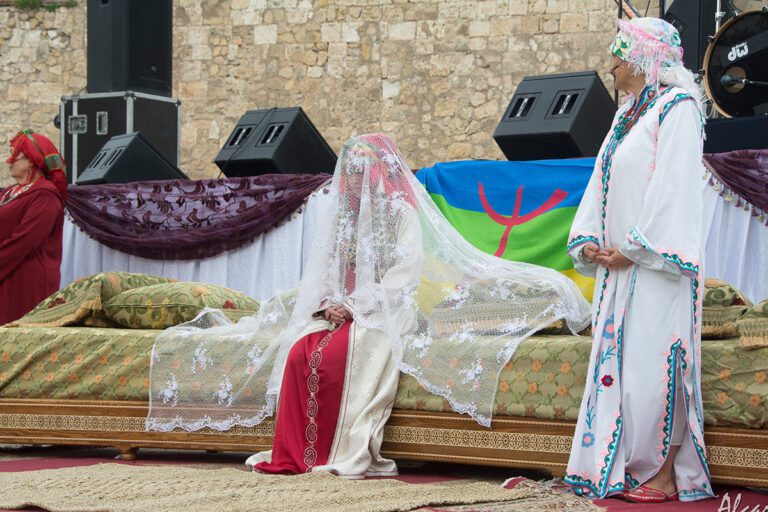Yennayer (or Yenayer) is said to be the Amazigh New Year, celebrated by the Berbers of North Africa from “all known eternity”, on a date that “strangely” falls on the same date as the Julian New Year, give or take a day or two.
The very name of Yennayer is said to be a transformation of the Latin name for the month, Januarius, or a Berber word meaning “first month”, or even “Divine Word”.
And Yennayer would be an agricultural festival.
If we start from the premise that Yennayer is an authentic Berber celebration, taking place on a date between 12 and 14 January, and not according to a lunar calendar, then we’re left with a whole host of questions revolving around “why, but why on earth?“.

I admit that I have a lot of problems with this, questions that I’ve been asking myself for several years. In this post, I give you all my questions, the answers in the next one.
To answer them, we need to take a diversion into the history of Christianity in North Africa, of Mauritania Tingitana and Caesaria (the ancient Roman provinces), and the history of this Christian calendar, long before the schism of 1054 between Catholics using the Gregorian calendar and Orthodox, or Byzantine, supporters of the Julian calendar.
In a much more recent history, we also need to look at the revitalisation of Amazigh heritage and the struggle of Berber associations and individuals (referred to in one commentary as “intellectuals from the Amazigh diaspora in Paris”, which is not entirely accurate).
A Berber agricultural festival in the middle of January?
Come on… although the Maghreb climate is mild, it’s the middle of winter. The harvest festivals are long over. The Imilchil festival, for example, used to take place in September, and the group weddings that took place there usually took place a month later. (In real life, before the Ministry of Tourism changed things).
In January, particularly in the mountains, we are in a period of restriction. The almond trees won’t start flowering again until February. That’s why, with the exception of roosters, hens and eggs, the Yennayer meal is essentially made up of cereals and dried fruits, foods that keep for a long time.

On the other hand, we’re already a long way from the winter solstice, which took place almost three weeks earlier, between 21 and 23 December, depending on the leap year.
From Mother Nature’s point of view, there’s absolutely nothing to celebrate on this date.
Why would the Julian calendar be synchronised with the Berber calendar?
The Julian calendar was introduced in 46 BC by Julius Caesar, and remained in use until it was replaced by the Gregorian calendar, roughly during the Renaissance. This means that ‘if’ this Berber New Year is linked to the Julian calendar, it’s not as old as all that.
What’s more, Mauritania Tingitana became a client of Rome much earlier, in 111 BC. It became a Roman province under Caligula, between 37 and 41.
We can nevertheless assume that the Berber kingdoms of the time gradually adapted to the Roman calendar, shifting their months at one time or another so that they were synchronised.
But there’s a big BUT: Mauritania Tingitana (and its smaller cousin to the east, Caesarian Mauritania) only covered a tiny part of the Berber country: in Morocco, the border ran roughly south of Volubilis, and in Algeria, the Roman province stopped at the Kabylie chains, without going any further.

Why January to start the Amazigh year?
This is where I really start to wonder. Januarius was not the first month but the 11th month of the Roman calendar at the time. In fact, it’s only with the reform of the Julian calendar that Ianuarius became the first month of the consular year, corresponding to the date on which the Consuls were elected in faraway Rome.
This was very important both administratively and politically: the years were designated by the name of the consul rather than by a serial number, taxes were set, etc. But there’s a small “but”: this use of the consular year existed long before the introduction of the Julian calendar and gradually lost its importance with the establishment of the Empire.
Once again, it only concerned the Roman provinces.
Why January – again – to start the Amazigh year?

In reality, the celebration of the New Year on 1 January (so, according to the Julian calendar, 13 January in our calendar) is far from self-evident.
In the Roman calendar, apart from the election of the Consuls, January 1st, or January Calends, is not a festival. Before that, the Saturnalia were celebrated.
The 1st of January became the first day of the consular year and was marked by the Feast of the Strenae, when small gifts were exchanged: sacred laurel or olive branches, figs, dates, honey and small coins. These will become our New Year’s gifts. Exceptionally, this calend is a day of great splendour, because you can’t imagine starting the year on a day of bad omen. They usually worked to ensure that the year is auspicious, but without excess.
Later in the month, the Compitalia, which marks the end of the agricultural year, is celebrated with honey cakes.
Was there only one Amazigh calendar?
Throughout Christian Europe, the date of the first of January did not become established until late in the Middle Ages or during the Renaissance (1752 in England, 1600 in Scotland, 1564 in France, 1556 in Spain). Before that, and depending on the region (yes, the region, not even the country), the New Year was celebrated on one of the following dates:
- 1 September, the start of the liturgical year in the Christian church
- 25 March, the feast of the Annunciation
- 25 December (the date was set to Christianise the Roman festival of Sol Invictus, which corresponded to the Solstice)
- 1 January, supposedly because it was the feast of the circumcision of Jesus and thus made it possible, once again, to Christianise the Roman January calendar
- Easter Day, which itself varies according to the lunar year (since Pesach is a Jewish festival, and therefore part of a lunisolar calendar).
We can therefore reasonably assume that the “Amazigh New Year” has not been any more fixed in almost 3,000 years than the others, whether Roman or even Christian. We can even assume (spoiler: rightly so) that there was no single Amazigh calendar.

In fact, very little is known about the Amazigh calendar before the Berber intellectuals.
Is Yennayer 12, 13 or 14 January?
We’ll be able to answer this question more precisely once we know what Yennayer really is. But in the meantime, the fact that the ‘Julian’ New Year is now 14 January means nothing!
Yes, as the Gregorian and Julian calendars don’t ‘make up’ for their differences in exactly the same way, the fact that the ‘Julian New Year’ today corresponds to 14 January doesn’t mean that this was the case when this new Berber calendar was created.
The creation of a Berber computation is necessarily arbitrary
Computation is a way of calculating time.
All calendars have been built in the same way. It is after the event that it is decided that the days and years will be counted.
- Whether it’s the Roman calendar (“Ab Urbe Condita“, from the founding of the city in 753 BC, a date that was finally set in marble towards the end of the first century BC)
- the Christian calendar, as described above
- the Hijri calendar, which was set by the Caliph Othman, deliberately taking a date slightly different from that of the Hegira, so as not to throw the calendar into disarray
- the Jewish calendar, which refers to the age of the generations of patriarchs who lived several hundred years ago
- and even the French revolutionary calendar, introduced in 1793 with a start date of 1792 (but it didn’t stand a chance – it didn’t even last thirty years).
The starting date of an ‘era’ is always arbitrary.

In the case of the Berber calendar, the date chosen by the person who created it was 12 January. From 950 BC.
Given that it’s arbitrary, I don't see the point of changing the date by one day, especially if it’s to “stick” to a historical reality of a Julian calendar that had very little to do with it.
Unless you have historical proof that Yennayer was actually celebrated on 14 January. And here, spoiler again, we don’t have any, because that wasn’t the case.
 A typo or syntax error? You can select the text and hit Ctrl+Enter to send us a message. Thank you! If this post interested you, maybe you can also leave a comment. We'd love to exchange with you !
A typo or syntax error? You can select the text and hit Ctrl+Enter to send us a message. Thank you! If this post interested you, maybe you can also leave a comment. We'd love to exchange with you !




